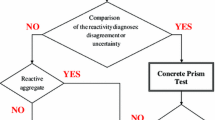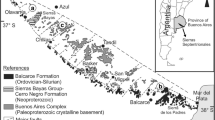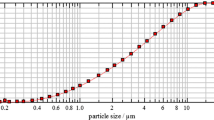Abstract
The alkali silica reaction (ASR), which originates in highly alkaline conditions in concrete where reactive forms of silica are available, causes serious damage to concrete structures. The ASR potential of various quartz-rich aggregates (pegmatite quartz, quartzite, quartz meta-greywacke, and chert) was quantified using accelerated mortar bar test (AMBT), chemical test (CT), and scanning electron microscopy combined with petrographic image analysis (SEM-PIA). Only two samples (quartz meta-greywacke, and pegmatite quartz) were judged as deleterious according to the CT; the other aggregates were classified as innocuous. AMBT gave different results. Quartz meta-greywacke, chert, and quartzite exceeded the 0.100 % expansion limit after 14 days of testing. Pegmatite quartz indicated a lower value. The results of SEM-PIA confirmed the results of AMBT, indicating the most extensive ASR in those AMBs containing chert and quartz meta-greywacke. Parts of aggregates were leached out and massive deposits of alkali–silica gels were found filling air voids, microcracks, and the aggregate/cement paste interface. The medium or low degree of ASR was confirmed in AMBs containing quartzite or pegmatite quartz, respectively. ASR accentuated pre-existing microcracks and formed new dissolution gaps. In contrast, no correlation was found with the results of CT, which under-evaluated the ASR potential of chert and quartzite and over evaluated the ASR potential of pegmatite quartz. The variable ASR potential of the investigated aggregates was explained by the significant content of poorly crystalline matrix (in chert and quartz meta-greywacke), and by the presence of strained quartz typical with undulose extinction and the origin of quartz subgrains (in quartzite and pegmatite quartz).







Similar content being viewed by others
References
ASTM C1260–07 (2007) Standard test method for potential alkali reactivity of aggregates (Mortar-bar method). ASTM International, West Conshohocken
ASTM C289 (2007) Standard test method for potential alkali-silica reactivity of aggregates (Chemical method). ASTM International, West Conshohocken
Bektas F, Topal T, Goncuoglu MC, Turanli L (2008) Evaluation of the alkali reactivity of cherts from Turkey. Constr Build Mater 22(6):1183–1190
ČSN 72 1179 (1968) Determination of reactivity of aggregates in connection with alkalies (in Czech). Czech Normalization Institute, Prague
Dreyer W (1973) The science of rock mechanics. Part I. The strength properties of rocks. Series on rock and soil mechanics, 2nd edn. Trans Tech, Clausthal
Dron R, Brivot F (1993) Thermodynamic and kinetic approach to the alkali–silica reaction. 2. Experiment. Cem Concr Res 23(1):93–103
Fernandes I (2015) Role of granitic aggregates in the deterioration of a concrete dam. Bull Eng Geol Environ 74(1):195–206
Fertig R, Tanner J (2012) Evaluation of ASR potential in Wyoming aggregates using multiple accelerated tests. In: Drimalas T, Ideker JH, Fournier B (eds) Proceedings of the 14th international conference on alkali-aggregate reaction, Austin, TX, 10 pp
Gao XX, Cyr M, Multon S, Sellier A (2013) A comparison of methods for chemical assessment of reactive silica in concrete aggregates by selective dissolution. Cem Concr Comp 37:82–94
Gillespie MR, Styles MT (1999) BGS rock classification scheme, vol 1, classification of igneous rocks. British Geological Survey; RR 99-06
Hasdemir S, Tuğrul A, Yilmaz M (2012) Evaluation of alkali reactivity of natural sands. Constr Build Mater 29:378–385
Hewlett PC (2003) Lea’s chemistry of cement and concrete, 4th edn. Butterworth-Heinemann, Oxford
Hünger K-J, Bachmann R, Scholz Y, Hübert C, Mo X (2008) An accelerated chemical test method for ASR carried out directly at aggregate grains. In: Broekmans MATM, Wigum BJ (eds) Proceedings of the 13th international Conference on alkali-aggregate reaction, Trondheim, Norway, pp 782–792
Kamenolomy ČR s.r.o. (2015) http://www.mineral-cesko.com/cz/provozovny-lomy/morava-jih/contactid_24/kamenolom-techobuz.aspx. Accessed 26 June 2015
Kuchařová A, Götze J, Šachlová Š, Pertold Z, Přikryl R (2015) Microscopic characterisation of crystalline and amorphous varieties of SiO2 exhibiting different ASR potential. Proceedings of the 37th Annual ICMA Conference, Seattle, WA, May 3–7, 2015, 15 pp
Lännstyrelssen Västernorrland (2015) http://www.lansstyrelsen.se/vasternorrland/Sv/djur-och-natur/friluftsliv/geologivagen/solleftea-kommun/edsele-gruva/Pages/default.aspx. Accessed 10 February 2015
Lindgård J, Nixon PJ, Borchers I, Schouenborg B, Wigum BJ, Haugen M, Åkesson U (2010) The EU “PARTNER” Project—European standard tests to prevent alkali reactions in aggregates: final results and recommendations. Cem Concr Res 40(4):611–635
Lindgård J, Andiç-Çakır Ö, Fernandes I, Rønning TF, Thomas MDA (2012) Alkali–silica reactions (ASR): literature review on parameters influencing laboratory performance testing. Cem Concr Res 42:223–243
Locati F, Marfil S, Baldo E (2010a) Effect of ductile deformation of quartz-bearing rocks on the alkali–silica reaction. Eng Geol 116(1–2):117–128
Locati F, Marfil S, Baldo E, Maiza P (2010b) Na2O, K2O, SiO2 and Al2O3 release from potassic and calcic-sodic feldspars into alkaline solutions. Cem Concr Res 40:1189–1196
Lu D, Fournier B, Grattan-Bellew PE (2006) Evaluation of accelerated test methods for determining alkali–silica reactivity of concrete aggregates. Cem Concr Compos 28(6):546–554
Oxford Instruments (2015) http://www.oxfordinstruments.com. Accessed 10 Sep 2015
Passchier CW, Trouw RAJ (2005) Microtectonics, 2nd edn. Springer, Berlin
Petruk W (1986) Image analysis: an overview of developments. CANMET Report 86-4E, pp 1–5
Přikryl R (2006) Assessment of rock geomechanical quality by quantitative rock fabric coefficients: limitations and possible source of misinterpretations. Eng Geol 87(3–4):149–162
Ramos VIM (2013) Characterization of the potential reactivity to alkalis of Portuguese aggregates for concrete. PhD Thesis, University of Porto, Porto, 417 pp
Ramos V, Fernandes I, Noronha F, Santos Silva A (2011) Petrographic characterization of granitic aggregates. Comparison with the results from laboratory tests. In: 13th Euroseminar on microscopy applied to building materials, Ljubljana, Slovenia, 10 pp
RILEM Recommended Test Method AAR-4.1 (2016) Detection of potential alkali-reactivity of aggregates. 60 °C accelerated method for aggregate combinations using concrete prisms. doi: 10.1007/978-94-017-7252-5
Robertson S (1999) BGS rock classification scheme, vol 2, classification of metamorphic rocks. British Geological Survey, RR 99-02
Rolim P, Gleize P, Hasparyk N, Monteiro P (2012) Chemical method and the variations in the test for siliceous rocks. In: Drimalas T, Ideker JH, Fournier B (eds) Proceedings of the 14th international conference on alkali-aggregate reaction, Austin, TX, 10 pp
Shayan A, Morris H (2001) A comparison of RTA T363 and ASTM C1260 accelerated mortar bar test methods for detecting reactive aggregates. Cem Concr Res 31(4):655–663
Shayan A, Xu A, Morris H (2008) Comparative study of the concrete prism test (CPT 60°C, 100% RH) and other accelerated tests. In: Broekmans MATM, Wigum BJ (eds) Proceedings of the 13th international conference on alkali-aggregate reaction, Trondheim, Norway, pp 412–421
SPI Supplies (2015) http://www.2spi.com. Accessed 10 Sep 2015
SPSS (2015) SigmaScan®Pro 5.0.0. http://www.sigmaplot.com/index.php. Accessed 22 July 2015
Šťastná A, Nekvasilová Z, Přikryl R, Šachlová Š (2013) Microscopic examination of alkali-reactive volcanic rocks from the Bohemian Massif (Czech Republic). In: The 3rd International conference on sustainable construction materials and technologies, Kyoto, Japan, 10 pp
Tescan (2015) http://www.tescan.com. Accessed 10 Sep 2015
TP 137 (2003) Elimination of alkaline reaction of aggregates in concrete structures. Road and Motorway Directorate of the Czech Republic technical regulations (in Czech)
Wakizaka Y (2000) Alkali–silica reactivity of Japanese rocks. Eng Geol 56(1–2):211–221
Wenk H-R, Monteiro PJM, Shomglin K (2008) Relationship between aggregate microstructure and mortar expansion. A case study of deformed granitic rocks from the Santa Rosa mylonite zone. J Mater Sci 43(4):1278–1285
Wigum BJ (1995) Examination of microstructural features of Norwegian cataclastic rocks and their use for predicting alkali-reactivity in concrete. Eng Geol 40(3–4):195–214
Wigum BJ, French WJ, Howarth RJ, Hills C (1997) Accelerated tests for assessing the potential exhibited by concrete aggregates for alkali-aggregate reaction. Cem Concr Compos 19(5–6):451–476
Acknowledgments
This study was supported financially from Research Project P104/12/0915 provided by the Czech Science Foundation. Special thanks go to Prof. Karel Miskovsky from Envix Nord AB for his assistance with the selection of Swedish samples. We also thank O. Šebek for the analysis of alkaline solutions employing inductively coupled plasma optical emission spectrometry.
Author information
Authors and Affiliations
Corresponding author
Rights and permissions
About this article
Cite this article
Šachlová, Š., Kuchařová, A., Pertold, Z. et al. Quantitative assessment of alkali silica reaction potential of quartz-rich aggregates: comparison of chemical test and accelerated mortar bar test improved by SEM-PIA. Bull Eng Geol Environ 76, 133–144 (2017). https://doi.org/10.1007/s10064-015-0812-z
Received:
Accepted:
Published:
Issue Date:
DOI: https://doi.org/10.1007/s10064-015-0812-z




